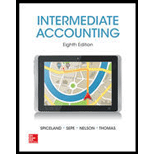
Intermediate Accounting w/ Annual Report; Connect Access Card
8th Edition
ISBN: 9781259546860
Author: J. David Spiceland
Publisher: McGraw-Hill Education
expand_more
expand_more
format_list_bulleted
Question
Chapter 12, Problem 12.3E
(1)
To determine
Financial Accounting Standards Board (FASB): FASB is the organization which creates, develops, and approves accounting standards; and administrates GAAP.
To attain: The literature related to accounting of investments in held-to-maturity securities from the FASB Codification Research System available at the FASB website
(2)
To determine
To mention: The specific citation in which the debt investment which is available to be sold, should not be classified and accounted for as held-to-maturity securities, are described
(3)
To determine
To mention: The circumstances and conditions in which the debt investment should not be classified and accounted for as held-to-maturity securities
Expert Solution & Answer
Want to see the full answer?
Check out a sample textbook solution
Students have asked these similar questions
How do deposit method criteria affect real estate sales recognition? a) Initial investment adequacy b) When title transfers c) Based on payment schedule d) Property delivery date. Need answer of this Accounting MCQ.
Can you help me solve this financial accounting question using valid financial accounting techniques?
Correct Answer
Chapter 12 Solutions
Intermediate Accounting w/ Annual Report; Connect Access Card
Ch. 12 - Prob. 12.1QCh. 12 - When market rates of interest rise after a...Ch. 12 - Does GAAP distinguish between fair values that are...Ch. 12 - When a debt investment is acquired to be held for...Ch. 12 - Prob. 12.5QCh. 12 - What is comprehensive income? Its composition...Ch. 12 - Why are holding gains and losses treated...Ch. 12 - Prob. 12.8QCh. 12 - Prob. 12.9QCh. 12 - Prob. 12.10Q
Ch. 12 - Prob. 12.11QCh. 12 - Prob. 12.12QCh. 12 - Do U.S. GAAP and IFRS differ in the amount of...Ch. 12 - Under what circumstances is the equity method used...Ch. 12 - The equity method has been referred to as a...Ch. 12 - In the application of the equity method, how...Ch. 12 - Prob. 12.17QCh. 12 - Prob. 12.18QCh. 12 - Prob. 12.19QCh. 12 - How does IFRS differ from U.S. GAAP with respect...Ch. 12 - What is the effect of a company electing the fair...Ch. 12 - Define a financial instrument. Provide three...Ch. 12 - Some financial instruments are called derivatives....Ch. 12 - Prob. 12.24QCh. 12 - Prob. 12.25QCh. 12 - Prob. 12.26QCh. 12 - (Based on Appendix 12B) Reporting an investment at...Ch. 12 - Prob. 12.28QCh. 12 - Explain how the CECL model (introduced in ASU No....Ch. 12 - Prob. 12.1BECh. 12 - Prob. 12.2BECh. 12 - Available -for-sale securities LO12-4 SL...Ch. 12 - Prob. 12.4BECh. 12 - Prob. 12.5BECh. 12 - Prob. 12.6BECh. 12 - Prob. 12.7BECh. 12 - Prob. 12.8BECh. 12 - Prob. 12.9BECh. 12 - Prob. 12.10BECh. 12 - Prob. 12.11BECh. 12 - Prob. 12.12BECh. 12 - Prob. 12.13BECh. 12 - Prob. 12.14BECh. 12 - Prob. 12.15BECh. 12 - Prob. 12.16BECh. 12 - Prob. 12.17BECh. 12 - Prob. 12.18BECh. 12 - Prob. 12.1ECh. 12 - Prob. 12.2ECh. 12 - Prob. 12.3ECh. 12 - Prob. 12.4ECh. 12 - Prob. 12.5ECh. 12 - Prob. 12.6ECh. 12 - Prob. 12.7ECh. 12 - Prob. 12.8ECh. 12 - Prob. 12.9ECh. 12 - Prob. 12.10ECh. 12 - Prob. 12.11ECh. 12 - Prob. 12.12ECh. 12 - Prob. 12.13ECh. 12 - Prob. 12.14ECh. 12 - Prob. 12.15ECh. 12 - Prob. 12.16ECh. 12 - Prob. 12.17ECh. 12 - Prob. 12.18ECh. 12 - Prob. 12.19ECh. 12 - Prob. 12.20ECh. 12 - Prob. 12.21ECh. 12 - Prob. 12.22ECh. 12 - Prob. 12.23ECh. 12 - Prob. 12.24ECh. 12 - Prob. 12.25ECh. 12 - Prob. 12.26ECh. 12 - Prob. 12.27ECh. 12 - Prob. 12.28ECh. 12 - Prob. 12.29ECh. 12 - Prob. 12.30ECh. 12 - Prob. 12.31ECh. 12 - Prob. 1CPACh. 12 - Prob. 2CPACh. 12 - Prob. 3CPACh. 12 - Prob. 4CPACh. 12 - Prob. 5CPACh. 12 - Prob. 6CPACh. 12 - Prob. 7CPACh. 12 - Prob. 8CPACh. 12 - Prob. 9CPACh. 12 - Prob. 10CPACh. 12 - Prob. 11CPACh. 12 - Prob. 12CPACh. 12 - Prob. 13CPACh. 12 - Prob. 1CMACh. 12 - Prob. 2CMACh. 12 - Prob. 3CMACh. 12 - Prob. 12.1PCh. 12 - Prob. 12.2PCh. 12 - Prob. 12.3PCh. 12 - Prob. 12.4PCh. 12 - Prob. 12.5PCh. 12 - Prob. 12.6PCh. 12 - Prob. 12.7PCh. 12 - Prob. 12.8PCh. 12 - Prob. 12.9PCh. 12 - Prob. 12.10PCh. 12 - Prob. 12.11PCh. 12 - Prob. 12.12PCh. 12 - Prob. 12.13PCh. 12 - P 12–14
Classifying investments
LO12–1 through...Ch. 12 - Prob. 12.15PCh. 12 - Prob. 12.16PCh. 12 - Prob. 12.17PCh. 12 - Prob. 12.18PCh. 12 - Prob. 12.1BYPCh. 12 - Prob. 12.2BYPCh. 12 - Case 12–4
Accounting for debt and equity...Ch. 12 - Prob. 12.6BYPCh. 12 - Prob. 12.7BYP
Knowledge Booster
Similar questions
arrow_back_ios
SEE MORE QUESTIONS
arrow_forward_ios
Recommended textbooks for you
 Auditing: A Risk Based-Approach (MindTap Course L...AccountingISBN:9781337619455Author:Karla M Johnstone, Audrey A. Gramling, Larry E. RittenbergPublisher:Cengage LearningPrinciples of Accounting Volume 1AccountingISBN:9781947172685Author:OpenStaxPublisher:OpenStax College
Auditing: A Risk Based-Approach (MindTap Course L...AccountingISBN:9781337619455Author:Karla M Johnstone, Audrey A. Gramling, Larry E. RittenbergPublisher:Cengage LearningPrinciples of Accounting Volume 1AccountingISBN:9781947172685Author:OpenStaxPublisher:OpenStax College

Auditing: A Risk Based-Approach (MindTap Course L...
Accounting
ISBN:9781337619455
Author:Karla M Johnstone, Audrey A. Gramling, Larry E. Rittenberg
Publisher:Cengage Learning

Principles of Accounting Volume 1
Accounting
ISBN:9781947172685
Author:OpenStax
Publisher:OpenStax College
